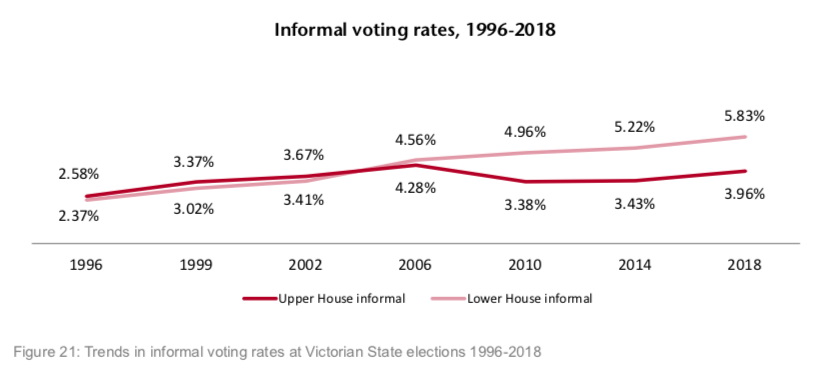The Electoral Matters Committee (EMC) of the Victorian parliament is currently holding an inquiry into the conduct of the 2018 state election, and as part of that process the Victorian Electoral Commission (VEC) has provided a long and detailed submission into the election, and over the next week I’ll be blogging about a few of the interesting elements of this submission.
The submission provides the results of the VEC’s survey of informal votes cast for the Legislative Assembly at the recent election, showing how the shape of the informal vote has changed.
The informal rate has been steadily increasing at Victorian state elections, as can be seen in this chart from the VEC submission:

The Legislative Assembly informal rate has increased at every election since 1996, from 2.6% to 5.8%. The Legislative Council informal rate peaked in 2006, which was the first election to use the proportional representation system, before dropping to a plateau in 2010 and 2014, but it has increased again in 2018. The report puts the blame for the increase in the upper house informal rate down to the increased number of candidates but it doesn’t look like the survey covers the upper house. I wouldn’t be surprised if the campaign to encourage voters to mark their own preferences may have led to some more informal votes.
The most interesting part of the report breaks down informal votes cast at the 2014 and 2018 elections into categories based on the markings on the ballot (p68).
| Informal vote type | 2014 % | 2018 % | ||
| Blank | 30.3 | 1.6 | 27.8 | 1.6 |
| Other intentional | 19.2 | 1.0 | 11.4 | 0.7 |
| Number 1 only | 23.0 | 1.2 | 24.9 | 1.5 |
| Numbers – insufficient | 9.8 | 0.5 | 7.3 | 0.4 |
| Numbers – sequence error | 10.5 | 0.6 | ||
| Numbers – other | 2.6 | 0.2 | ||
| Ticks/crosses preference | 8.1 | 0.4 | 9.9 | 0.6 |
| Ticks/crosses other | 3.9 | 0.2 | ||
| Writing – other | 2.1 | 0.1 | 1.8 | 0.1 |
This table shows the breakdown firstly as a proportion of the informal vote, and then as a proportion of the total vote.
The VEC divides informal votes into those that appear to be intentional and those who appear to be accidental. The intentional informal votes dropped from 49.5% to 39.3%. This is still a drop when you factor in the increase in the total informal vote: apparently intentional informal votes dropped from 2.6% to 2.3%.
The increases were across the board, but hard to pick precisely because there appear to be more categories in 2018 than in 2014.
The VEC also published data breaking down types of informal votes by electorate (p106). This map shows the rate of apparently intentional informal votes, while it can be toggled to show the rate of apparently accidental informal votes. You can click on each seat to see the stats in each state, both as a proportion of the total vote and as a proportion of the informal vote.
There are some areas which tend to rank more highly in both categories: in particular suburbs with larger non-English-speaking populations. But I find it interesting that electorates with large ballot papers mostly rank highly amongst “accidental” informal votes.
Melton and Morwell voters had to choose from twelve and eleven candidates respectively, while ten candidates nominated in Bentleigh and Mordialloc. Melton and Morwell ranked third and fifth in the state for the rate of apparently accidental informal votes. Melton also ranked first in the state for apparently intentional informal votes, but the other three seats ranked much lower on this measure.
We’ve known for a while that very large ballot papers increase the informal rate, so it’s interesting to see how much of that increase comes from voters simply giving up, or unsuccessfully trying to vote. It seems that in Melton and to a lesser extent Morwell some voters looked at the ballot paper and threw up their hands, but the high informal rate was more driven by voters trying and failing.
I’m sure there’s more interesting trends in the electorate-level data, so please post your thoughts in the comments.


